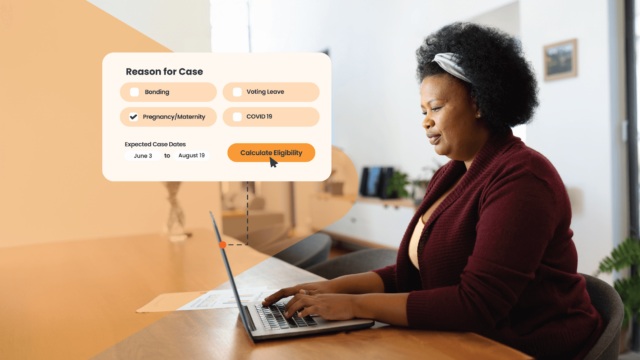


The need to retain talent remains a top priority for many organizations to stay competitive. Companies today are realizing the importance of supporting their employees through all stages of life, including pregnancy and postpartum. With the Pregnant Workers Fairness Act (PWFA) now in effect, it’s also required by law.
In a recent survey, the majority of employees reported that 11-40% of their workforces take maternity leave every year. This can add up to a significant number of employees, especially at large organizations. With so many potentially impacted employees, it’s critical to understand the protections granted by law, as well as the benefits of providing support through every stage of pregnancy.
In this article, we’ll look at the current regulations in place for protecting employees, and what potential accommodations might look like, how to improve your interactive process, and more.
The Pregnant Workers Fairness Act (PWFA) went into effect on June 27th, 2023. This act bridges the gap between the ADA and Title VII. The PWFA classifies every pregnancy as a disability, meaning employees with a wide range of pregnancy-related conditions will be able to request reasonable accommodations.
In April 2024, the EEOC added new guidelines that take effect on June 18, 2024. These guidelines clarify some key differences between the ADA and the PWFA, including:
In addition, the PUMP Act which went into effect on April 28th of 2023, expands existing employer obligations under the Fair Labor Standards Act to provide an employee with reasonable break time to express breast milk for the employee’s nursing child up to one year after the child’s birth.
During pregnancy and postpartum, employees may experience physical or mental conditions that can limit their ability to perform certain tasks. Each pregnancy-related condition will produce different challenges, so it’s important to use a personalized approach and interactive process to understand their limitations.
In the EEOC guidelines, some accommodations were noted that should not impose an undue hardship and should be granted in virtually all situations.
These “predictable assessments” include:
Other accommodations that can help employees with pregnancy-related conditions be productive could include:
Of course, this is not an extensive list of accommodations an employee might be provided. Many more reasonable accommodations for pregnancy-related conditions can be viewed at the Job Accommodations Network.
For those needing accommodations for breastfeeding, that can be covered under the PUMP act which requires employers to provide a place to express milk shielded from view and intrusion from coworkers or the public and will cover all mothers up to one year after the birth of a child.
In addition, leave can be considered a reasonable accommodation for many pregnancy-related conditions. Because pregnancy requires regular visits to the doctor and other necessary appointments, intermittent leave can be a great way to support these appointments. A long term leave of absence can be considered for some pregnancy-related conditions such as a needed hospital stay or bed rest if telework is unavailable.
It should be easy and relatively inexpensive for organizations to provide accommodations for most pregnancy-related conditions. In fact, the U.S. Equal Employment Opportunity Commission specified in its final rule implementing the PWFA that most accommodation requests under the PWFA “can be provided quickly and typically will consist of nothing more than brief conversations and email exchanges.”
Fifty percent of the HR professionals we surveyed in the 2023 Pregnant Workers Fairness Act Readiness Survey either had no formal accommodation processes in place or had just a few processes but relied primarily on spreadsheets, email reminders, and disparate apps.
Many employers are now seeing a sharp increase in accommodations requests now that the PWFA is in effect. Employers need to think about how they can create a better interactive process to stay compliant and keep up with growing caseloads.
As EEOC’s regulations take effect, employers need to ensure their interactive process is fast and employees with pregnancy-related conditions are accommodated quickly. Accommodations management platforms like AbsenceSoft save significant amounts of time through automation. Here are some other ways that accommodation software can improve your interactive process:
Accommodation software with self-service capabilities provide employees a clear and discrete place to go when they need to request accommodation. For example, AbsenceSoft’s Employee Self-Service (ESS) portal allows employees to make a request anytime, anywhere, from any device they choose. This keeps the entire accommodation process simple, straightforward, and private.
Many times, employees will make requests for accommodations directly to their managers. That’s why it is important to train managers about their responsibilities under laws like the PWFA, the ADA, and any state and local protections.
Proper training will help managers understand when a request is being made, and make sure they respond appropriately. You also want to help managers understand how to protect the confidentiality of the employee making the request.
When you use an accommodations management platform, you get a single source of truth for your accommodations cases. The platform can document the start of the interactive process and automate all of the administrative tasks involved. This gives your team the foundation for a speedy interactive process, and employees can get their requested accommodations much faster.
Every part of the interactive process can be easily documented and stored in an accommodations management platform. You can automate reminders to follow up with employees to make sure their accommodations are working well. If not, you can quickly restart the interactive process in the system if they need additional support.
Accommodations management software lets you centralize, capture, and view all your accommodations data. You can regularly analyze the outcomes of each case to make sure your decisions have been as fair and consistent as possible. In addition, you can generate reports or export audit trails so that you have all the data you need at your fingertips.
With streamlined accommodations workflows, each employee can experience the same process, every time. The platform guides the case management process, so every HR team member can provide a clear, supportive, and personalized experience.
While these laws levy new demands employers must satisfy, they also give employers the opportunity to build more support into their workplace culture — a change that will ultimately make their workforce happier and healthier.
Employers can manage this transition with ease when they tap the right technology. To learn more about how accommodation software can improve your interactive process, visit the AbsenceSoft website, or chat with one of our ADA experts.